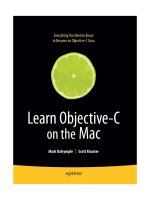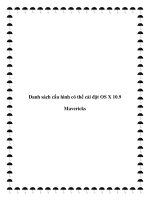apress learn objective-c on the mac, for os x and ios 2nd (2012)
Bạn đang xem bản rút gọn của tài liệu. Xem và tải ngay bản đầy đủ của tài liệu tại đây (12.24 MB, 370 trang )
Learn Objective-C
on the Mac
For iOS and OS X
Scott Knaster
Waqar Malik
Mark Dalrymple
Learn Objective-C for iOS and OS X
Copyright © 2012 by Scott Knaster, Waqar Malik, Mark Dalrymple
This work is subject to copyright. All rights are reserved by the Publisher, whether the whole or part of the material is
concerned, specifically the rights of translation, reprinting, reuse of illustrations, recitation, broadcasting, reproduction
on microfilms or in any other physical way, and transmission or information storage and retrieval, electronic adaptation,
computer software, or by similar or dissimilar methodology now known or hereafter developed. Exempted from this
legal reservation are brief excerpts in connection with reviews or scholarly analysis or material supplied specifically
for the purpose of being entered and executed on a computer system, for exclusive use by the purchaser of the work.
Duplication of this publication or parts thereof is permitted only under the provisions of the Copyright Law of the
Publisher's location, in its current version, and permission for use must always be obtained from Springer. Permissions
for use may be obtained through RightsLink at the Copyright Clearance Center. Violations are liable to prosecution
under the respective Copyright Law.
ISBN 978-1-4302-4188-1
ISBN 978-1-4302-4189-8 (eBook)
Trademarked names, logos, and images may appear in this book. Rather than use a trademark symbol with every
occurrence of a trademarked name, logo, or image we use the names, logos, and images only in an editorial fashion and
to the benefit of the trademark owner, with no intention of infringement of the trademark.
The use in this publication of trade names, trademarks, service marks, and similar terms, even if they are not identified
as such, is not to be taken as an expression of opinion as to whether or not they are subject to proprietary rights.
While the advice and information in this book are believed to be true and accurate at the date of publication, neither
the authors nor the editors nor the publisher can accept any legal responsibility for any errors or omissions that may be
made. The publisher makes no warranty, express or implied, with respect to the material contained herein.
President and Publisher: Paul Manning
Lead Editor: Steve Anglin
Development Editors: Gwenan Spearing, Matthew Moodie
Technical Reviewer: Nick Waynik
Editorial Board: Steve Anglin, Ewan Buckingham, Gary Cornell, Louise Corrigan, Morgan Ertel, Jonathan Gennick,
Jonathan Hassell, Robert Hutchinson, Michelle Lowman, James Markham, Matthew Moodie, Jeff Olson, Jeffrey
Pepper, Douglas Pundick, Ben Renow-Clarke, Dominic Shakeshaft, Gwenan Spearing, Matt Wade, Tom Welsh
Coordinating Editor: Brent Dubi
Copy Editor: Heather Lang
Compositor: SPi Global
Indexer: SPi Global
Artist: SPi Global
Cover Designer: Anna Ishchenko
Distributed to the book trade worldwide by Springer Science+Business Media New York, 233 Spring Street,
6th Floor, New York, NY 10013. Phone 1-800-SPRINGER, fax (201) 348-4505, e-mail ,
or visit www.springeronline.com.
For information on translations, please e-mail , or visit www.apress.com.
Apress and friends of ED books may be purchased in bulk for academic, corporate, or promotional use. eBook versions
and licenses are also available for most titles. For more information, reference our Special Bulk Sales–eBook Licensing
web page at www.apress.com/bulk-sales.
Any source code or other supplementary materials referenced by the author in this text is available to readers at www.
apress.com. For detailed information about how to locate your book’s source code, go to www.apress.com/source-code/.
This is for my family—of course!
–Scott
For my parents, M. Saleem and Kalsoom A. Malik,
who have always provided unconditional encouragement, support and help
in all of my endeavors.
–Waqar
v
Contents at a Glance
Foreword xvii
About the Authors xix
About the Technical Reviewer xxi
Acknowledgments xxiii
Working with This Book xxv
Chapter 1: Hello N 1
Chapter 2: Extensions to C N 7
Chapter 3: Introduction to Object-Oriented Programming N 21
Chapter 4: Inheritance N 53
Chapter 5: Composition N 67
Chapter 6: Source File Organization N 79
Chapter 7: More About Xcode N 91
Chapter 8: A Quick Tour of the Foundation Kit N 119
Chapter 9: Memory Management N 145
Chapter 10: Object Initialization N 177
Contents at a Glancevi
Chapter 11: Properties N 195
Chapter 12: Categories N 209
Chapter 13: Protocols N 227
Chapter 14: Blocks and Concurrency N 239
Chapter 15: Introduction to UIKit N 255
Chapter 16: Introduction to the Application Kit N 277
Chapter 17: File Loading and Saving N 293
Chapter 18: Key-Value Coding N 303
Chapter 19: Using the Static Analyzer N 319
Chapter 20: NSPredicate N 329
Appendix A N 339
Index 349
vii
Contents
Foreword xvii
About the Authors xix
About the Technical Reviewer xxi
Acknowledgments xxiii
Working with This Book xxv
Chapter 1: Hello N 1
Before You Start 1
Where the Future Was Made Yesterday 2
What’s Coming Up 2
Getting Ready 3
Summary 6
Chapter 2: Extensions to C N 7
The Simplest Objective-C Program 7
Building Hello Objective-C 7
Deconstructing Hello Objective-C 12
That Wacky #import Thing 12
Contentsviii
Introducing Frameworks 13
NSLog() and @"strings" 13
Are You the Boolean Type? 16
Mighty BOOL in Action 16
Summary 20
Chapter 3: Introduction to Object-Oriented Programming N 21
It’s All Indirection 22
Variables and Indirection 22
Indirection Through Filenames 25
Using Indirection in Object-Oriented Programming 31
Procedural Programming 31
Implementing Object Orientation 36
Time Out for Terminology 41
OOP in Objective-C 42
The @interface Section 42
The @implementation Section 45
Instantiating Objects 48
Extending Shapes-Object 49
Summary 51
Chapter 4: Inheritance N 53
Why Use Inheritance? 53
Inheritance Syntax 56
Time Out for Terminology 59
How Inheritance Works 59
Method Dispatching 59
Instance Variables 61
Overriding Methods 63
I Feel Super! 64
Summary 65
Contents
ix
Chapter 5: Composition N 67
What Is Composition? 67
Car Talk 68
Customizing for NSLog() 68
Accessor Methods 71
Setting the Engine 72
Setting the Tires 73
Tracking Changes to Car 74
Extending CarParts 75
Composition or Inheritance? 76
Summary 77
Chapter 6: Source File Organization N 79
Split Interface and Implementation 79
Making New Files in Xcode 80
Breaking Apart the Car 83
Using Cross-File Dependencies 85
Recompiling on a Need-to-Know Basis 86
Making the Car Go 87
Importation and Inheritance 88
Summary 90
Chapter 7: More About Xcode N 91
One Window to Rule Them All 91
Changing the Company Name
93
Using Editor Tips and Tricks 94
Writing Your Code with a Little Help from Xcode 95
Indentation (Pretty Printing) 95
You Complete Me 96
Kissing Parentheses 99
Mass Edits 99
Navigating Around in Your Code 104
Contentsx
Focus Your Energy 105
The Navigation Bar Is Open 106
Getting Information 108
Debugging 111
Crush Puny Bugs 111
Xcode’s Debugger 111
Subtle Symbolism 112
Let’s Debug! 112
Taking a Look-See 115
Cheat Sheet 116
Summary 117
Chapter 8: A Quick Tour of the Foundation Kit N 119
Solid Foundation 119
Using the Project Boilerplate Code 120
Some Useful Types 120
Home on the Range 120
Geometric Types 121
Stringing Us Along 122
Build That String 122
Class Methods 122
Size Matters 123
Comparative Politics 124
Insensitivity Training 125
Is It Inside? 126
Mutability 126
Collection Agency 128
NSArray 128
Mutable Arrays 133
Enumeration Nation 134
Fast Enumeration 134
Contents
xi
NSDictionary 135
Use but Don’t Extend 137
Family Values 138
NSNumber 138
NSValue 139
NSNull 140
Example: Looking for Files 140
Behind the Sign That Says “Beware of the Leopard” 143
Summary 144
Chapter 9: Memory Management N 145
Object Life Cycle 146
Reference Counting 146
Object Ownership 148
Retaining and Releasing in Accessors 148
Autorelease 150
Everyone into the Pool! 150
The Eve of Our Destruction 151
Pools in Action 152
The Rules of Cocoa Memory Management 154
Transient Objects 155
Hanging on to Objects 156
Take Out Those Papers and the Trash 158
Automatic Reference Counting 159
Being Exceptional 170
Keywords for Exceptions 171
Catching Different Types of Exceptions 172
Throwing Exceptions 172
Exceptions Need Memory Management Too 174
Exceptions and Autorelease Pools 174
Summary 175
Contentsxii
Chapter 10: Object Initialization N 177
Allocating Objects 177
Initializing Objects 178
Writing Initialization Methods 178
What to Do When You’re Initializing 180
Isn’t That Convenient? 180
More Parts Is Parts 182
Init for Tires 182
Updating main() 184
Cleaning Up the Car 186
Car Cleaning, GC and ARC Style 189
Making a Convenience Initializer 189
The Designated Initializer 190
The Subclassing Problem 191
Fixing Tire’s Initializers 192
Adding the AllWeatherRadial Initializer 193
Initializer Rules 194
Summary 194
Chapter 11: Properties N 195
Shrinking Property Values 195
Shrinking the Interface 196
Shrinking the Implementation 197
Dots Incredible 200
Objecting to Properties 201
Appellation Spring 204
Read-Only About It 206
I’d Rather Do It Myself 207
Alas, Properties Don’t Do Everything 208
Summary 208
Contents
xiii
Chapter 12: Categories N 209
Creating a Category 209
Let’s Create a Category 210
@interface 211
@implementation 212
Bad Categories 214
Good Categories 214
Clint Eastwood Would Love This 215
Splitting an Implementation with Categories 216
Using Categories in our Project 216
Making Forward References with Categories 219
Categories to the Rescue! 220
Informal Protocols and Delegation Categories 221
The ITunesFinder Project 221
Delegates and Categories 224
Responds to Selectors 225
Other Uses for Selectors 225
Summary 226
Chapter 13: Protocols N 227
Formal Protocols 227
Declaring Protocols 228
Adopting a Protocol 228
Implementing a Protocol 229
Car-bon Copies 229
Copying Engines 230
Copying Tires 231
Copying the Car 232
Protocols and Data Types 235
Objective-C 2.0 Goodies 235
The Delegation Will Come to Order 236
Summary 238
Contentsxiv
Chapter 14: Blocks and Concurrency N 239
You’re Never Too Old to Play with Blocks 239
Blocks and Function Pointers 239
Objective-C Objects 243
Concurrency, or Keeping Up with Yourself 244
Synchronize 244
Memory Management Is for Queues Too 248
Operation Queues 251
Summary 252
Chapter 15: Introduction to UIKit N 255
View Controllers 260
Adding Items to the Nib File 260
Summary 276
Chapter 16: Introduction to the Application Kit N 277
Making the Project 278
Making the Delegate @interface 280
Interface Builder 281
Laying Out the User Interface 282
Making Connections 285
Hooking Up the Outlets 285
Hooking Up the Actions 287
AppDelegate Implementation 289
Summary 291
Chapter 17: File Loading and Saving N 293
Property Lists 293
NSDate 293
NSData 294
Writing and Reading Property Lists 295
Modifying Objects 297
Contents
xv
Encoding Objects 297
Summary 302
Chapter 18: Key-Value Coding N 303
A Starter Project 303
Introducing KVC 305
A Path! A Path! 306
Aggregated Assault 307
Pit Stop 308
Smooth Operator 311
Life’s a Batch 313
The Nils Are Alive 314
Handling the Unhandled 315
Summary 316
Chapter 19: Using the Static Analyzer N 319
Getting Some Static 319
Going Into Analysis 320
Assisting the Analyzer 324
On Further Analysis 325
Summary 327
Chapter 20: NSPredicate N 329
Creating a Predicate 330
Evaluate the Predicate 330
Fuel Filters 331
Format Specifiers 333
Hello Operator, Give Me Number 9 334
Comparison and Logical Operators 334
Array Operators 335
Contentsxvi
SELF Sufficient 336
String Operations 337
Like, Fer Sure 338
That’s All, Folks 338
Appendix A N 339
Index 349
xvii
Foreword
Whenever software developers adopt a new platform, they are faced with the daunting task of
familiarizing themselves with the programming language, development tools, design patterns,
and standard software libraries available in the new environment.
Typically, this must be done simultaneously with writing code under pressure to deliver it as
quickly as possible, and developers are tempted to fall back on approaches they know from
previous systems. This often results in code that doesn't really fit the platform, that may duplicate
functionality that already existed, and can cause maintenance headaches down the road.
In an ideal world, new developers would have the benefit of colleagues who are already familiar
with the platform, who can offer their guidance to get them started and moving in the right
direction. Unfortunately, the very success of the iOS platform has made for many cases where
this just isn't possible.
If you don't have a mentor handy, what's the next best thing?
The authors of this book are veterans of Apple's Developer Technical Services organization, and
they have each answered countless questions from software engineers who are new to Apple's
technology. They have been responsible for instilling good habits in those they've helped. That
experience results in a book that anticipates the most common misunderstandings and takes
care to explain not only the how, but also the why of Apple's development platform.
For example, the conceptual basis provided in Chapter 3, "Introduction to Object-Oriented
Programming," gives you the means to place the material that follows it into a coherent
picture, instead of just tossing you into the midst of a flurry of unfamiliar classes, methods, and
techniques and hoping that you'll somehow sort it all out with practice.
Learn Objective-C on the Mac is a fine guide to the language at the heart of Apple’s iOS and OS
X development platform.
John C. Randolph
xix
About the Authors
Scott Knaster was at Apple when Apple wasn’t cool. Scott worked at Apple
helping developers write Mac software in the earliest days of the platform,
when Cocoa was just a great idea waiting to be born. Scott now works on
Google’s Developer Relations team and runs the Google Mac Blog. He lives
in Silicon Valley among his nerdy peers.
Waqar Malik is a UNIX nerd and has been for long time. He worked at
Apple during the early days of Mac OS X, helping developers with Cocoa
and UNIX. He now works for MeLLmo, Inc. in San Diego, writing great iOS
Software.
Mark Dalrymple is a longtime Mac and Unix programmer who has worked
on cross-platform toolkits, Internet publishing tools, high-performance web
servers, and end-user desktop applications. He’s also the principal author
of Advanced Mac OS X Programming (Big Nerd Ranch 2005). In his spare
time, he plays trombone and bassoon and makes balloon animals.
xxi
About the Technical
Reviewer
Nick Waynik has been working in the IT field for over 13 years and has done
everything from network administration to web development. He started
writing iOS apps at the beginning of 2008 when the SDK was released. Since
then, he has gone on to start his own business focusing on iOS development.
In his spare time, he loves to spend time with his wife and family and play
golf. He blogs at nickwaynik.com and can be found on Twitter as @n_dubbs.
xxiii
Acknowledgments
This book didn’t write itself, you know. And we, the authors, didn’t do all the work either—not
even close. Sure, we typed a bunch of words and code, but without our amazing book team,
what would we have? A really long blog post, maybe.
Enormous thanks go to Brent Dubi, who held everything together with relentlessly cheerful
e-mails and focused phone calls, both vital tools in coordinating a virtual team of people from
around the world. Thanks to Nick Waynik for keeping us technically honest, which is not an easy
task given the power and complexity that Apple packs into Xcode and Cocoa nowadays. We
thank Gwenan Spearing, who scoured every word we wrote, even the bad puns, to help us make
sure we were as clear and concise as possible. And second-edition thanks to our excellent first-
edition copy editor, Heather Lang, who returned and once again allowed us to push the limits
of proper grammar and style just so we could make yet another nerdy Star Wars joke. Each of
these folks improved this book immeasurably and so have made us look our best.
Waqar would also like to thank his wonderful children, Adam and Mishal, and his beautiful wife,
Irrum, for giving him enough time to work on this book.
xxv
Working with This Book
To download source code or report an error, please see this book's page on the Apress site:
www.apress.com/9781430241881.
For best results when using this book, have your computer close by while you read. Having your
favorite beverage at hand is also nice, but keep it away from the computer, because liquid damage
repair prices will ruin your whole day.
Most of all, have fun while you learn this stuff!









